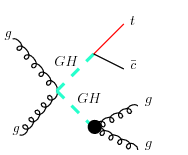| Version 6 (modified by , 10 years ago) ( diff ) |
|---|
A Coloron Model
Corresponding Authors
- Elizabeth Drueke (Michigan State University)
- Reinhard Schwienhorst (Michigan State University)
- Natascia Vignaroli (Michigan State University)
- Devin G. E. Walker (SLAC National Accelerator Laboratory)
- Jiang-Hao Yu (The University of Texas at Austin)
Other Contributors
- Joseph Nutter (Michigan State University)
- R. Sekhar Chivukula (Michigan State University)
- Elizabeth H. Simmons (Michigan State University)
Description of the Model
The
$SU(3)_1 \times SU(3)_2 \to SU(3)_C$
breaking induced by the expectation value of the
({$\bf 3,\bar{ 3}$})
scalar field Phi generates color-octet and color-singlet scalars. The most general renormalizable potential for Phi is:
$V(\Phi)=-m^2_{\Phi}\text{Tr}(\Phi\Phi^\dagger) -\mu (\text{det }\Phi+\text{H.c.})+\frac{\xi}{2}\left[ \text{Tr}(\Phi\Phi^\dagger) \right]^2+\frac{k}{2}\text{Tr}(\Phi\Phi^\dagger\Phi\Phi^\dagger) \ ,$
where
$\text{det } \Phi = \frac{1}{6}\epsilon^{ijk}\epsilon^{i'j'k'}\Phi_{ii'}\Phi_{jj'}\Phi_{kk'} \ ,$
and where, without loss of generality, one can choose mu > 0. Assuming
$m^2_\Phi >0$,
Phi acquires a (positive) diagonal expectation value:
$\langle \Phi \rangle = u \cdot \mathcal{I} \,.$
The Phi expansion around the vacuum gives:
$\Phi=u+\frac{1}{\sqrt{6}}\left(\phi_R+i\phi_I\right)+\left(G^a_H+iG^a_G\right)T^a \ ,$
where
$\phi_R$, $\phi_I$
are singlets under SU(3)_C Additionally,
$G^a_G$, $a=1,\dots,8$,
are the Nambu-Goldstone bosons associated with the color-symmetry breaking, and
$G^a_H$
are color octets.
GH can be produced in pairs through its interactions with gluons:
$\frac{g^2_s}{2}f^{abc}f^{ade}G^b_{\mu}G^{\mu d}G^c_H G^e_H +g_s f^{abc} G^a_{\mu} G^b_H \partial^{\mu} G^c_H \ ,$
or it can be produced singly via gluon-gluon fusion. This occurs at one-loop order through the cubic interaction
$\frac{\mu}{6} d_{abc} G^a_H G^b_H G^c_H \,,$
which arises from the
$\mu(\det\Phi+\text{H.c.})$
term in the potential; where
$d_{abc}$
is the SU(3) totally symmetric tensor. The single production of GH can be described by the effective coupling
$-\frac{1}{4} C_{ggG} d_{abc} G^a_{\mu\nu} G^{\mu\nu b} G^c_H$
with
$C_{ggG}=\sqrt{\frac{1}{6}}\frac{\alpha_s}{\pi }\frac{\mu}{M^2_{G_H}}\left(\frac{\pi^2}{9}-1\right) \ .$
Note that single production is suppressed by a factor
$(\pi^2/9 -1)^2$,
which is an accidental suppression factor coming from the loop. Above the threshold for decays into a single top quark, GH has two main decay modes: the decay into gluons, which occurs at loop-level similar to single coloron production, and the flavor-violating decay into tc. The corresponding rates are:
$\Gamma \left[G_H \to (\bar{c}_L t_R +\bar{t}_R c_L )\right] =\left(V_{cb}\right)^2 \frac{M_{G_H}}{16 \pi} \frac{m^2_t}{u^2}\left(1-\frac{m^2_t}{M^2_{G_H}}\right)^2 \,, $ \newline $\Gamma \left[G_H \to gg \right]=\frac{5 \alpha^2_s}{1536 \pi^3}\frac{\mu^2}{M_{G_H}}\left(\frac{\pi^2}{9}-1\right)^2 \,.$
We set u=mu (the stability of the potential forbids mu>u); and consider for simplicity the set of
$(M_{G_H}, \mu)$
values that give a 50% GH decay into tc and 50% into gg. GH is a very narrow resonance, with a width of the order of 10-4 GeV.
Various Feynman Diagrams for GH processes discussed in 1409.7607v2 are shown below:
Model Files
- proc_card: for generation of 500 GeV coloron (place in Cards/)
- run_card: for generation of 500 GeV coloron (place in Cards/)
- Octet-tcgg: the model
Generation specifics
In 1409.7607v2, the samples were generated with the coloron mass as the scale, dsqrt_q2fact1, and dsqrt_q2fact2 in the run_card.dat file. These samples were also generated without MadGraph cuts as demonstrated in the run_card.dat for 500 GeV mass included above. The specific generations run were
p p > GH, GH > b c~ l+ vl @1 GHT=1 QED=2 p p > GH, GH > b~ c l- vl~ @2 GHT=1 QED=2
To generate the settings for a specific coloron mass, use the appropriate model directory contained in the Octet-tcgg zip file.
Attachments (8)
-
Coloron.png
(2.0 KB
) - added by 10 years ago.
Feynman Diagram 1
-
ColoronDouble1.png
(2.6 KB
) - added by 10 years ago.
Feynman Diagram 2
-
ColoronDouble2.png
(2.7 KB
) - added by 10 years ago.
Feynman Diagram 3
-
Colorong.png
(2.1 KB
) - added by 10 years ago.
Feynman Diagram 4
-
Colorong2.png
(2.5 KB
) - added by 10 years ago.
Feynman Diagram 5
-
proc_card_mg5.dat
(2.4 KB
) - added by 10 years ago.
process card for a 500 GeV mass coloron
-
run_card.dat
(13.8 KB
) - added by 10 years ago.
run card for a 500 GeV mass coloron
-
Octet-tcgg-new.zip
(163.9 KB
) - added by 10 years ago.
model
Download all attachments as: .zip





